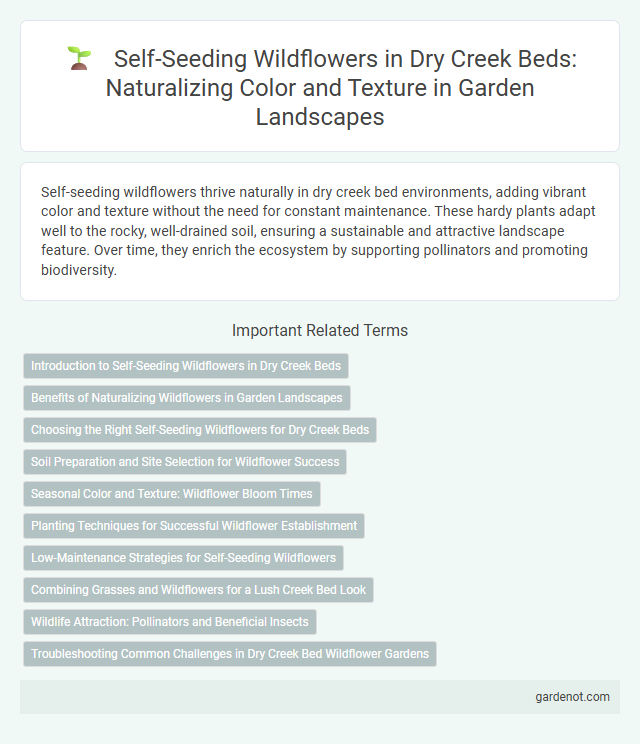Self-seeding wildflowers thrive naturally in dry creek bed environments, adding vibrant color and texture without the need for constant maintenance. These hardy plants adapt well to the rocky, well-drained soil, ensuring a sustainable and attractive landscape feature. Over time, they enrich the ecosystem by supporting pollinators and promoting biodiversity.
Introduction to Self-Seeding Wildflowers in Dry Creek Beds
Self-seeding wildflowers naturally disperse seeds, promoting effortless growth and vibrant blooms in dry creek beds. These plants enhance erosion control while supporting local biodiversity by attracting pollinators such as bees and butterflies. Ideal species for dry creek beds include yarrow, lupine, and California poppy, which thrive in well-drained, rocky soils.
Benefits of Naturalizing Wildflowers in Garden Landscapes
Self-seeding wildflowers in dry creek beds enhance garden landscapes by promoting biodiversity and supporting pollinators such as bees and butterflies. These resilient plants require minimal maintenance, improve soil health through natural erosion control, and create a vibrant seasonal display that adapts to local climate conditions. Incorporating native wildflowers encourages ecological balance and sustainability while reducing the need for chemical fertilizers and irrigation.
Choosing the Right Self-Seeding Wildflowers for Dry Creek Beds
Selecting drought-tolerant self-seeding wildflowers such as California poppies, yarrow, or black-eyed Susans ensures vibrant blooms in dry creek beds. These species thrive in well-drained, rocky soils and require minimal irrigation once established, promoting natural reseeding and low maintenance. Incorporating native wildflowers enhances biodiversity and supports local pollinators while stabilizing soil in erosion-prone areas.
Soil Preparation and Site Selection for Wildflower Success
Loosen well-drained, sandy or loamy soil with a pH between 6.0 and 7.5 to enhance seed germination and root development for self-seeding wildflowers. Choose a dry creek bed site that receives full sun to partial shade, ensuring minimal water retention to mimic natural wildflower habitats. Remove competing vegetation and avoid compacted areas to promote optimal seed-to-soil contact and increase wildflower success rates.
Seasonal Color and Texture: Wildflower Bloom Times
Self-seeding wildflowers in dry creek beds offer vibrant seasonal color and diverse texture, with blooms peaking from early spring through late summer. Species like California poppies, lupines, and baby blue eyes provide continuous floral displays, enhancing visual interest and ecological benefits. Staggered bloom times create dynamic patchworks that support pollinators and contribute to soil stabilization along dry creek beds.
Planting Techniques for Successful Wildflower Establishment
Planting self-seeding wildflowers in a dry creek bed requires well-prepared soil with good drainage and minimal compaction to promote root growth. Seed dispersal techniques such as broadcasting seeds during early fall or spring, combined with light raking to ensure seed-soil contact, enhance germination rates. Mulching with a thin layer of straw or biodegradable material helps retain moisture and protects seeds from erosion and predation.
Low-Maintenance Strategies for Self-Seeding Wildflowers
Self-seeding wildflowers thrive in dry creek beds due to their adaptability to well-drained, nutrient-poor soils, reducing the need for frequent watering and fertilization. Selecting native species like California poppies or black-eyed Susans enhances natural reseeding while minimizing maintenance efforts. Implementing mulch layers or natural debris protects seeds from erosion and promotes successful germination in these arid conditions.
Combining Grasses and Wildflowers for a Lush Creek Bed Look
Combining self-seeding wildflowers with native grasses enhances the natural aesthetic of a dry creek bed by creating a diverse, textured landscape that supports local pollinators. Varieties like Black-eyed Susan, Brown-eyed Susan, and Little Bluestem grass establish a resilient ground cover that adapts well to fluctuating moisture levels. This blend not only promotes soil stability but also offers vibrant seasonal color, attracting butterflies and bees throughout the growing season.
Wildlife Attraction: Pollinators and Beneficial Insects
Self-seeding wildflowers in a dry creek bed create a rich habitat that attracts diverse pollinators such as bees, butterflies, and hummingbirds, enhancing local biodiversity. These native plants provide continuous nectar sources and shelter for beneficial insects, promoting natural pest control. The resulting ecosystem supports healthy pollination cycles critical for surrounding vegetation and agricultural productivity.
Troubleshooting Common Challenges in Dry Creek Bed Wildflower Gardens
Self-seeding wildflowers in dry creek bed gardens often face challenges like poor germination due to inconsistent moisture and soil erosion that displaces seeds. Improving soil structure with organic mulch and creating micro-depressions can help retain water and protect seeds from runoff. Selecting drought-tolerant native species enhances resilience, reducing the need for frequent intervention.
Self-seeding wildflower Infographic

 gardenot.com
gardenot.com